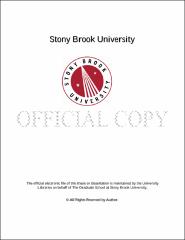| dc.identifier.uri | http://hdl.handle.net/11401/77761 | |
| dc.description.sponsorship | This work is sponsored by the Stony Brook University Graduate School in compliance with the requirements for completion of degree. | en_US |
| dc.format | Monograph | |
| dc.format.medium | Electronic Resource | en_US |
| dc.language.iso | en_US | |
| dc.publisher | The Graduate School, Stony Brook University: Stony Brook, NY. | |
| dc.type | Thesis | |
| dcterms.abstract | The aquatic biological community of the Hudson River Estuary (HRE) was examined using traditional and novel sampling techniques. A 16-year trawl, seine, and fish trap data set collected aboard the Hudson River Sloop Clearwater and Schooner Mystic Whaler from 1999-2015 was compiled and analyzed. Fish and crab species assemblages, geographic distributions, seasonal patterns, and abundance changes over the study period were analyzed and correlated to environmental conditions and climate variations. A biological acoustic survey of the HRE was conducted from 2013-2015 using a scientific echosounder hull-mounted to the Sloop Clearwater. Fish trawl and zooplankton tow data collected during this time period were used to ground-truth the bioacoustic records. Spatial and temporal patterns in biological scattering from pelagic fish and zooplankton were analyzed in relation to environmental conditions, trophic interactions, climate variability, and region. Chapter 1 Abstract: The temporal and spatial abundance and distribution of Hudson River Estuary fish and crab were examined using trawl, seine and trap data from 1999-2015. During this time period, fish abundance (as measured by catch per unit effort) was highest in 2003 and 2012. Patterns in organism abundance were investigated by examining the Hudson River Estuary regionally, seasonally, and by species. Each of the four geographic regions (Albany, Poughkeepsie, Piermont, and New York City) studied had different assemblages of dominant species. Seasonal abundance patterns between regions were found for blue claw crab (Callinectes sapidus), hogchoker (Trinectes maculatus), and white perch (Morone americana). Generalized linear models predicted a higher white perch presence in the downriver regions (Piermont and NYC) when water temperatures were lower and dissolved oxygen concentrations were higher. Lower white perch abundances were predicted for the upriver regions (Albany and Poughkeepsie) for the same environmental conditions. Higher catch per unit effort values for dominant species of fish and crab were associated with negative phase North Atlantic Oscillation index values in the upriver regions only (Albany and Poughkeepsie). Lower catch per unit effort values were observed during above average freshwater discharge rates, especially in the New York City Region. Chapter 2 Abstract: Pelagic fish and zooplankton abundance and distribution in the Hudson River Estuary (HRE) were quantified from August 2013 to September 2015 using a scientific echosounder mounted to the Hudson River Sloop Clearwater. Integrated acoustic backscatter from fish and zooplankton varied greatly within each day due to the patchy distribution of organisms. However, clear seasonal trends were evident each year with increases in the abundance of both fish and zooplankton occurring in the spring and fall. Freshwater discharge rates were associated with changes in the distribution of both fish and zooplankton in the estuary. High freshwater discharge decreased zooplankton abundance throughout the entire HRE and shifted the distribution of organisms downriver. These same conditions decreased fish abundance in the upper and lower estuary resulting in a more concentrated fish distribution centered near Poughkeepsie, NY. Acoustic surveys provide a non-invasive way to efficiently survey the distribution and abundance of pelagic organisms in a large estuarine system. | |
| dcterms.available | 2017-09-20T16:53:31Z | |
| dcterms.contributor | Warren, Joseph D | en_US |
| dcterms.contributor | Cerrato, Robert | en_US |
| dcterms.contributor | Nye, Janet. | en_US |
| dcterms.creator | Niemisto, Maija Liisa | |
| dcterms.dateAccepted | 2017-09-20T16:53:31Z | |
| dcterms.dateSubmitted | 2017-09-20T16:53:31Z | |
| dcterms.description | Department of Marine and Atmospheric Science | en_US |
| dcterms.extent | 99 pg. | en_US |
| dcterms.format | Application/PDF | en_US |
| dcterms.format | Monograph | |
| dcterms.identifier | http://hdl.handle.net/11401/77761 | |
| dcterms.issued | 2016-12-01 | |
| dcterms.language | en_US | |
| dcterms.provenance | Made available in DSpace on 2017-09-20T16:53:31Z (GMT). No. of bitstreams: 1
Niemisto_grad.sunysb_0771M_12999.pdf: 3117245 bytes, checksum: bdb3dc7b13bc5e1251009afb7c1c4ad2 (MD5)
Previous issue date: 1 | en |
| dcterms.publisher | The Graduate School, Stony Brook University: Stony Brook, NY. | |
| dcterms.subject | Aquatic sciences -- Ecology | |
| dcterms.subject | Acoustics, Clearwater, Fish, Hudson River, Trawl, Zooplankton | |
| dcterms.title | Temporal and spatial distribution and abundance of fish, crab, and zooplankton in the Hudson River Estuary from 1999-2015 using trawl and biological acoustic techniques | |
| dcterms.type | Thesis | |

